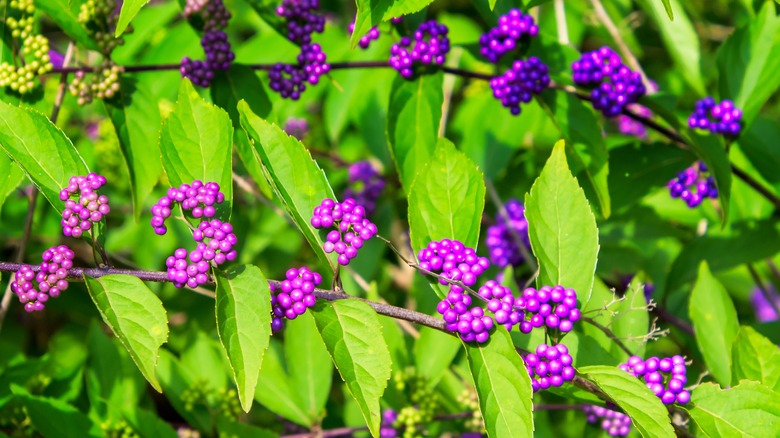Birds Can't Get Enough Of This Sparkling Shrub's Little Black Berries
Do you love birds and want to attract more of them to your yard? Sure, you can go the typical route with feeders or a birdhouse your feathered friends will love, but why not try a more natural approach? Enter the sparkleberry bush — a bird's best friend, packed with little blackberries that they can't resist.
The sparkleberry, a relative of the blueberry, is a native North American shrub that thrives in various regions. It has gorgeous green leaves and small blossoms that bloom from late spring to early summer before those fertile blooms are replaced by berries during the late summer to fall season. It is a pretty enough shrub for your yard, but what makes the sparkleberry such a bird magnet?
First, the shiny black color of the berries is visually appealing to birds. They stand out against the green foliage and can be easily spotted from afar. Second, sparkleberries contain high levels of natural sugars, making them an energy-packed snack for birds. Lastly, unlike some other berry bushes, sparkleberries have small seeds that are easy for birds to digest. This means they can quickly consume and enjoy their tasty treat without any hassle. All in all, they are a win-win for birds everywhere.
How do you grow a sparkleberry?
Planting a sparkleberry bush is relatively straightforward. Native to zones 6 through 9, this hardy shrub can withstand a variety of weather conditions. It's not just a seasonal beauty; the sparkleberry is tough enough to handle both heat and cold. When it comes to growth, patience is key. The bush takes a few years to mature, but once it does, you'll see berries within the first three to four years. A fully-grown sparkleberry bush can reach up to 20 feet, making it a substantial addition to any yard, so make sure you have enough room and are willing to get out there and trim and prune so you don't have to tame your overgrown shrub later down the line.
If you're ready to roll up your sleeves and get planting, here are some quick tips. For the sparkleberry, choose a sunny spot in your garden, although it can tolerate partial shade. It prefers sandy, dry soil but will tolerate soil that is wet on occasion. Plant it in the fall or early spring for the best results and make sure to water it regularly during its first year to help establish its roots, though once it's settled, it's pretty low maintenance. You might also want to consider planting it near other trees or bushes, as this provides a natural habitat and makes birds feel more secure.
What are some sparkleberry alternatives?
Love sparkleberry but want a few other options to both diversify your backyard and attract more birds to your backyard? Let's talk about two alternatives that you can plant right along with your "sparkler." First up is the American beautyberry (Callicarpa Americana). This native shrub produces vibrant purple berries that birds can't resist. It's hardy in zones 6-10 and grows relatively quickly, usually around three to five years to start fruiting. Plus, it's easy to maintain and resistant to most pests and diseases.
Next on the list is the black chokeberry (Aronia melanocarpa). Despite its somewhat ominous name, it's a hit among our winged friends, who love the dark berries that grow throughout September to November and even well into the winter months in warmer locations. Chokeberries grow well in zones 4 to 9 and are quite resilient. Like the sparkleberry, they are versatile in terms of soil conditions and require minimal maintenance. It takes about two to four years for this bush to start producing berries, making it a quicker option for those who want to see results just a bit quicker.


